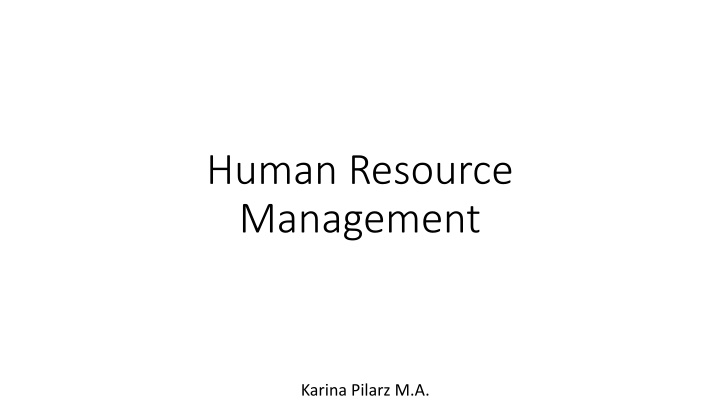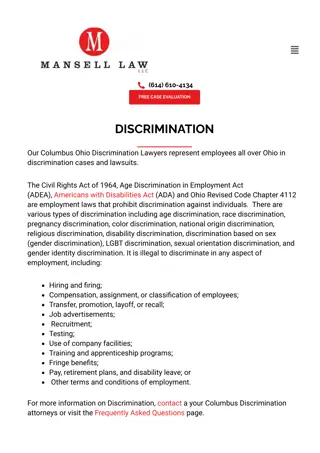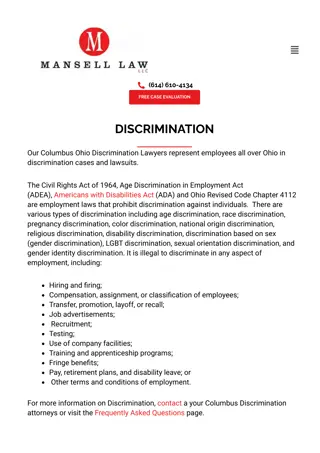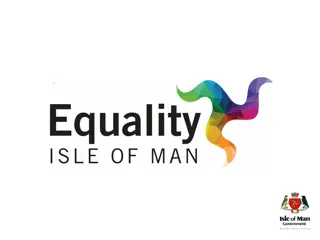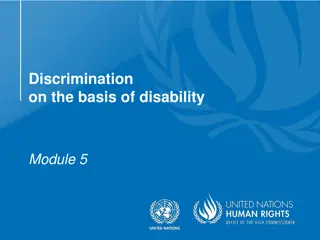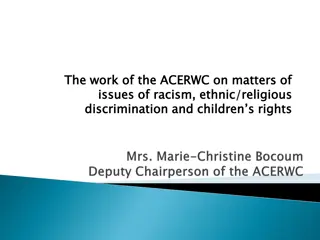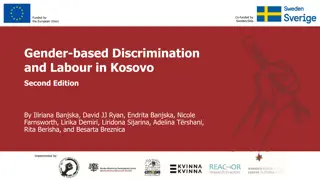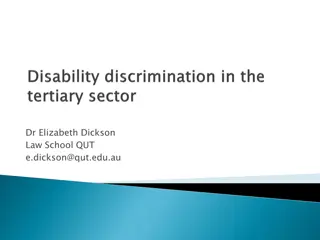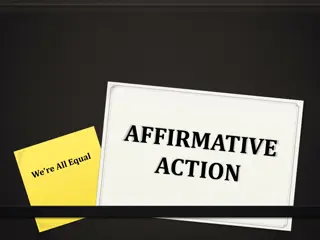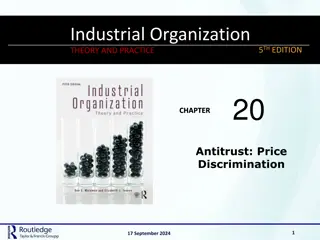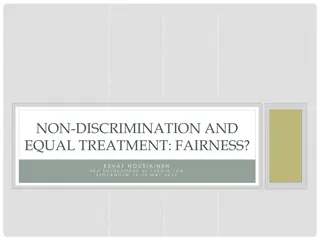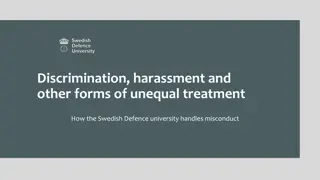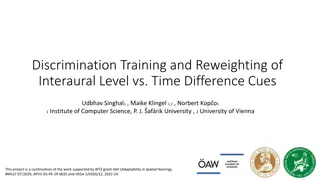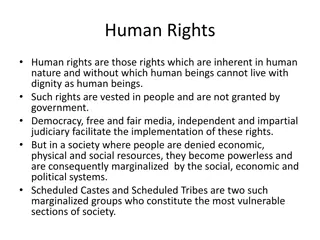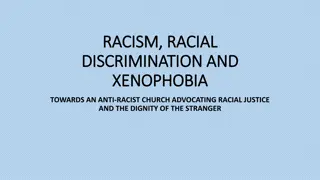Impact of Discrimination on Different Groups
Discrimination refers to unfair treatment based on factors like sex, race, disability, and age. Its impact varies among groups due to different forms and responses. Understanding the nature of discrimination is crucial for effective management.
Download Presentation

Please find below an Image/Link to download the presentation.
The content on the website is provided AS IS for your information and personal use only. It may not be sold, licensed, or shared on other websites without obtaining consent from the author.If you encounter any issues during the download, it is possible that the publisher has removed the file from their server.
You are allowed to download the files provided on this website for personal or commercial use, subject to the condition that they are used lawfully. All files are the property of their respective owners.
The content on the website is provided AS IS for your information and personal use only. It may not be sold, licensed, or shared on other websites without obtaining consent from the author.
E N D
Presentation Transcript
Human Resource Management Karina Pilarz M.A.
TASK TASK Try to define discrimination and describe its potential impact on different groups. To zdj cie, autor: Nieznany autor, licencja: CC BY-SA
https://www.youtube.co m/watch?v=f12Cu3fPiFw https://www.youtube.co m/watch?v=Sc-Ck2h_rNE https://www.youtube.co m/watch?v=BdFw_i03V0 A To zdj cie, autor: Nieznany autor, licencja: CC BY-SA-NC
DISCRIMINATION DISCRIMINATION As situations, discrimination refers to behavior that has the purpose or effect of individuals by virtue of their membership in class. The term discrimination therefore legally encompasses a wide range conducts, and processes that produce differential without justification. applied to employment harming some a protected To zdj cie, autor: Nieznany autor, licencja: CC BY-NC of attitudes, results appropriate
The nature of discrimination One of the assumptions sometimes made is that discrimination is experienced in the same way by different groups of people. In other words, discrimination based on sex, race/ethnicity, disability and age is often assumed to be the same. While it is certainly the case that the effects of discrimination (the disadvantage suffered) are the same or very similar for the victims, the nature of the discrimination often differs and the response and attitudes of the social groups can also differ.
One starting point for this is to consider the characteristics that identify a person as different: sex, age, ethnicity, etc. In particular, these characteristics differ in terms of whether they can be considered stable and visible. Stable characteristics are features such as race and sex with the exception of the tiny minority of people that undergo gender reassignment. In contrast a person s age differs throughout their life, thus everyone is susceptible to being a victim of ageism, and the type of ageism will change at different life stages. Visible characteristics are features that a person cannot hide such as sex, race/ethnicity and some forms of disability. Others, such as sexual orientation, can be hidden and so although discrimination occurs, some potential victims can dodge it through behaviour that disguises their true identities.
The picture is of diversity in the nature of discrimination and difference in the needs of the various groups and individuals that experience discrimination. These are important issues because it means: Managers should not assume that discrimination means the same thing irrespective of group concerned. Managers should not assume that a policy solution for one social group (for example, women) will be appropriate or welcomed by a different social group (for example, disabled people). Managers should expect that attitudes will differ within social groups (for example, Asian employees and black employees). The recognition of this diversity has led some commentators to argue that rather than defining people by their similarities to others, managers should see all employees as individuals with unique skills and needs.
Why Why managers managers should are are disadvantaged disadvantaged and should care and suffer care whether whether some suffer unfair unfair treatmen some people people treatment? t? The social justice case is that managers have a moral obligation to treat employees with fairness and dignity. Part of this involves ensuring that decisions are made without resorting to prejudice and stereotypes. If decisions are made free from prejudice and stereotyping then there is a lower risk of any particular group being disadvantaged and therefore less chance of an individual feeling that he or she has been discriminated against. Critics of the social justice case tend to argue that while the pursuit of fairness is laudable, it is not the prime concern of organisations. The goals of managers in organisations are profit and efficiency, rather than morality. If social justice were to guide their decision making it might have a detrimental effect on the operation of the business and ultimately the bottom line. This line of argument has led to an additional rationale for equality and diversity: the business case.
The second set of arguments that can be used to justify why managers should be concerned with eliminating disadvantage is based on making a business case. The point is that, aside from any concerns with social justice, fair treatment simply makes good business sense for four main reasons. 1 It is a better use of human resources. By discriminating on the basis of sex, race/ethnicity, disability, and so on, managers run the risk of neglecting or overlooking talented employees. The consequence is that the organisation fails to maximise its full human resource potential and valuable resources are wasted through under-utilising the competences of existing employees or losing disgruntled, talented staff to other organisations. 2 It leads to a wider customer base. By broadening the diversity of the workforce, managers might help the organisation to appeal to a greater range of customers. This might be particularly important where face-to-face service delivery is a central part of the business and requires an understanding of the diverse needs of customers. 3 It creates a wider pool of labour for recruitment. By being more open-minded about the people they could employ for various jobs, managers will have a wider pool of talent from which to recruit. This is particularly important when an organisation is attempting to secure scarce resources, such as employees with specific skills or experience. 4 It leads to a positive company image. By having a clear statement of the organisation s commitment to fair treatment, backed by meaningful practices that result in a diverse workforce, managers will be able to project a positive image of the organisation to customers, suppliers and potential employees. In terms of employees, the organisation will be perceived as good to work for because it values ability and talent, and so is more likely to attract and retain high-calibre people.
As we can see, the two sets of arguments are not necessarily mutually exclusive. Indeed, it is feasible and practical for managers to use both sets to justify equality or diversity initiatives in their organisations. It reflects a pragmatic realisation that by stressing both arguments there is more chance of gaining commitment to equality and diversity from a wider group of people. Whether a manager is committed to equality because of justice or business sense reasons does not really matter it is the fact he or she is committed that counts.
Equality Equality and and diversity diversity policies policies If the issue of disadvantage is to be addressed in a systemic and consistent way within an organisation, then it is advantageous to have an overall policy that guides decision making and action. Increasingly such policies are being created, although the terminology differs from organisation to organisation: some call them equal opportunity policies, others diversity policies and still others use both terms. The rationale for such policies can be based on a mix of justice and business sense arguments. The form of these policies varies between organisations.
The ten points that follow are from the website of the UKs Commission for Racial Equality (www.cre.gov.uk) and are typical of the recommended good practice that employers are encouraged to adopt. The initiatives from 3 to 10 are often described as positive action (or affirmative action ) and organisations are encouraged to adopt some, if not all, of these. 1 Develop an equal opportunities policy, covering recruitment, promotion and training. 2 Set an action plan, with targets, so that you and your staff have a clear idea of what can be achieved and by when. 3 Provide training for all people, including managers, throughout your organisation, to ensure they understand the importance of equal opportunities. Provide additional training for staff who recruit, select and train your employees. 4 Assess the present position to establish your starting point, and monitor progress in achieving your objectives. 5 Review recruitment, selection, promotion and training procedures regularly, to ensure that you are delivering on your policy. 6 Draw up clear and justifiable job criteria, which are demonstrably objective and jobrelated. 7 Offer pre-employment training, where appropriate, to prepare potential job applicants for selection tests and interviews; consider positive action training to help ethnic minority employees to apply for jobs in areas where they are under-represented. 8 Consider your organisation s image: do you encourage applications from under-represented groups and feature women, ethnic minority staff and people with disabilities in recruitment literature, or could you be seen as an employer who is indifferent to these groups? 9 Consider flexible working, career breaks, providing childcare facilities, and so on, to help women in particular meet domestic responsibilities and pursue their occupations; and consider providing special equipment and assistance to help people with disabilities. 10 Develop links with local community groups, organisations and schools, in order to reach a wider pool of potential applicants.
To ensure the effectiveness of equal and diversity policies, the organisation needs to adopt positive action initiatives and ensure monitoring takes place. These two components are a feature of those organisations categorised as proactive , so they need some elaboration. Positive action Positive action (sometimes called affirmative action) means one or more specific initiatives designed to encourage under-represented groups to apply for jobs or promotion within the organisation. Positive action might also be concerned with making changes to working arrangements to encourage the retention of employees by making the environment more suited to the needs they have that differ from the majority of employees. It is important not to confuse the term positive action with positive discrimination . The latter means the preferential treatment of a person because of their sex, ethnicity, age and so forth, and this is unlawful under most discrimination law within Europe.
Monitoring One of the key ways of helping to ensure the effectiveness of policies is through the use of equality monitoring. This is a process of systematically collecting and analysing data on the composition of the workforce, particularly with regard to recruitment and promotion. The rationale behind monitoring is that it is impossible for managers to make an assessment of what action to take (if any) unless they are aware of the current situation.
Criticism of equal and diversity policies The first of these is that they are sometimes not worth the paper they are written on. Just because an organisation has a policy, it does not mean that the policy is effective. Indeed, it might be argued that in some organisations managers want to present the positive image of being aware of equality concerns, but do not wish to introduce procedures or initiatives that might (in their opinion) constrain or limit their decisions about who to appoint, train, promote and so on. A second criticism is that formal policies do not prevent managers from finding ways of evading or distorting the procedures. A third criticism is that even where managers are working within the procedures, there is a huge amount of informal practice and discretion that means unfair treatment can persist.
Institutional Institutional discrimination discrimination One of key issues that managers must face is whether their organisation operates in ways that are fundamentally discriminatory. This is sometimes referred to as institutional racism, institutional sexism, institutional homophobia, and so on. The term means that rather than discrimination being seen simply as the actions of individuals, it is deep-rooted in the processes and culture of the organisation. Examples of processes that are sometimes described as evidence of institutional discrimination are: Word-of-mouth methods for recruitment. Dress codes that prevent people practising their religious beliefs. Promotions based on informal recommendations, rather than open competition. Informal assessments rather than formal appraisals. Assumptions about training capabilities. Assumptions about language difficulties and attitudes. Often these types of processes are not recognised as being discriminatory and have been in operation for many years. It is only when a company is faced with a legal challenge that such practices are seen to be having a discriminatory impact. Managers should regularly scrutinise organisational procedures, and the use of data collected through equality monitoring can be particularly effective in highlighting areas whether the processes might be disadvantaging particular groups.
Tasks 1. We don t employ people over 50 years old because they find it difficult to learn new skills. This statement was made by a training manager in a call centre. Comment on the statement using the concepts of stereotyping, prejudice, social justice and the business case. 2. What is the purpose of equality and diversity policies? Why do they sometimes fail to live up to expectations? 3. I treat everyone the same so that s how I ensure fairness. This quote is from a section manager in a supermarket. Explain why such an approach can sometimes lead to unfairness.
